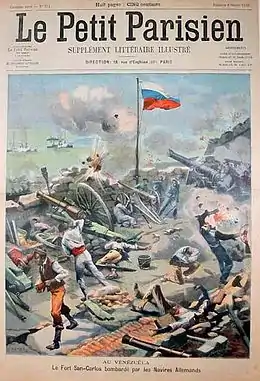Bombardment of Fort San Carlos
The Bombardment of Fort San Carlos occurred during the Venezuelan Crisis on January 17, 1903, when two warships of the Imperial German Navy tried to penetrate into Lake Maracaibo but were repulsed by the garrison of Fort San Carlos de la Barra after a brief exchange of fire.[2]
| Bombardment of Fort San Carlos | |||||||
|---|---|---|---|---|---|---|---|
| Part of the Venezuelan Crisis | |||||||
 Front page of "Le Petit Parisien" depicting the bombardment of Fort San Carlos | |||||||
| |||||||
| Belligerents | |||||||
|
|
| ||||||
| Commanders and leaders | |||||||
|
|
| ||||||
| Strength | |||||||
|
4 artillery pieces 1 fort |
1 light cruiser 1 gunboat | ||||||
| Casualties and losses | |||||||
| 3–6 wounded | 1 gunboat damaged | ||||||
| 25-40 civilians killed | |||||||
Bombardment
On January 17, SMS Panther and SMS Falke were chasing a merchant schooner which had evaded the blockade and entered the lake. Both ships intended to enter the lake and blockade the city of Maracaibo.[3]
Guarding the entrance that connects the lake with the Gulf of Venezuela was the castle of San Carlos de la Barra. The shallow waters that connected lake Maracaibo with the sea were only passable for major ships in the strait that separated San Carlos from the island of Zapara, yet even there it was needed the help of a local pilot to sort the sand banks and shallow waters of the passage.
The captain of the Panther, not knowing the bathymetry of shallow waters of the site, ran aground on the sandbars, between the island of San Carlos and the island of Zapara, near the Castle of San Carlos de la Barra, so it was within shooting range of his artillery. Soon after, the ships began a bombardment of the fortress and the Venezuelan troops responded. The Venezuelan artillerymen Manuel Quevedo and Carlos José Cárdenas with an 80 mm Krupp cannon, by coincidence of German manufacture, managed to make several impacts in the SMS Panther, leaving it severely damaged. After half an hour of combat, the Germans withdrew. In this action six people were injured in the San Carlos castle under the command of General Jorge Antonio Bello. Three days later, on January 20, the German protected cruiser SMS Vineta arrived from Puerto Cabello in relief of the damaged Panther, the cruiser arrived at the castle of San Carlos and bombarded it for eight hours. Intentionally or not, the ship's fire also reached the nearby port, killing between 25 and 40 civilians.
Aftermath

Four days later the Panther returned to reduce the fort, accompanied by the protected cruiser SMS Vineta, with a much larger armament. A typical bombardment ensued for 8 hours, although outgunned the Venezuelan garrison attempted to resist with their cannon but by the end of the conflict, Fort San Carlos was in ruins and burning. Shells also hit the nearby port; whether intentional or not, the bombardment killed 25 civilians, prompting the arrest of German and British citizens by Venezuelan authorities.[4][5]
The action had not been approved by the British commander of the "Particular Service Squadron" Commodore Robert Archibald James Montgomerie, who had been warned by Admiralty after the Puerto Cabello bombardment of 13 December not to engage in such action without consulting London; the message was not passed to the German commander, who had been told previously to follow the English commander's lead. The incident caused "considerable negative reaction in the United States against Germany". The Germans said that the Venezuelans fired first, which the British concurred with but declared the bombardment "unfortunate and inopportune" nonetheless.
The German Foreign Office said that the Panther's attempted incursion into the lagoon of Maracaibo had been motivated by a desire to ensure the effective blockade of Maracaibo port, by preventing it from being supplied across the adjacent Colombian border. Subsequently the US president Theodore Roosevelt informed the German Ambassador that Admiral George Dewey had orders to be ready the Caribbean fleet to sail from Puerto Rico to Venezuela at an hour's notice.
See also
References
- GERMANS SHELL A FORT - New York Times. January 19, 1903
- GERMAN COMMANDER BLAMES VENEZUELANS - New York Times. January 24, 1903
- GERMAN COMMANDER BLAMES VENEZUELANS - New York Times. January 24, 1903
- GERMAN COMMANDER BLAMES VENEZUELANS - New York Times. January 24, 1903
- Theodore Roosevelt's 'Cuban Missile Crisis': Venezuela 1902